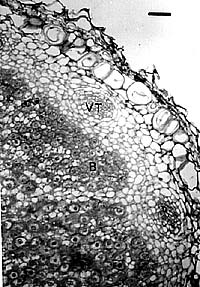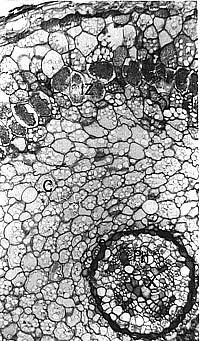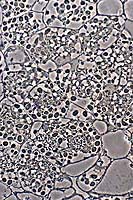
Alnus glutinosa (LM)
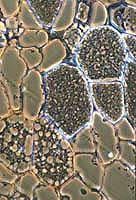
Casuarina cunninghamiana
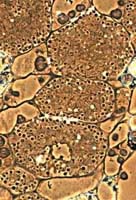
Ceanothus americanus
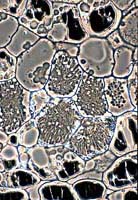
Morella (Myrica) cerifera
Examples of vesicle types of Frankia in root nodules. They range from filamentous in Casuarina to large and spherical in Alnus. With Myrica having club-shaped structures and Ceanothus having small pear-shaped, nonseptate vesicles. (R. H. Berg)
The nodules on actinorhizal plants differ markedly from those initiated by rhizobia on legumes. Legume nodules have a central infected zone within an endodermis and a cortical layer of tightly packed cells; vascular tissue is peripheral. Actinorhizal nodules have a central stele that has infected tissue adjacent to it, or that lies within a cylinder of infected cortical cells.
Within the nodule Frankia cells produce "colonizing hyphae" that penetrate cell walls, and "proliferating hyphae" that branch in host cells (Newcomb, 1987). In older infected plant cells, vesicles are present with a variety of shapes depending on the plant. Alnus and Elaeagnus have large spherical, mulitseptate vesicles, while members of the Rosaceae and Ceanothus have non-septate elliptical vesicles. Coriaria, Myrica, and Comptonia have simple club-shaped hyphal swellings, while Casuarina strains remain hyphal (Newcomb, 1987). Examples of the various types are shown at top.
The bundles of hyphae and vesicles present in an infected plant cell are called "vesicle clusters", or "hyphal clusters." They are the starting material for isolation attempts, for DNA preparations in diversity studies, or physiological studies in the plant. Some examples of vesicle clusters are shown above. For a closer view of Frankia in root nodules go here.
